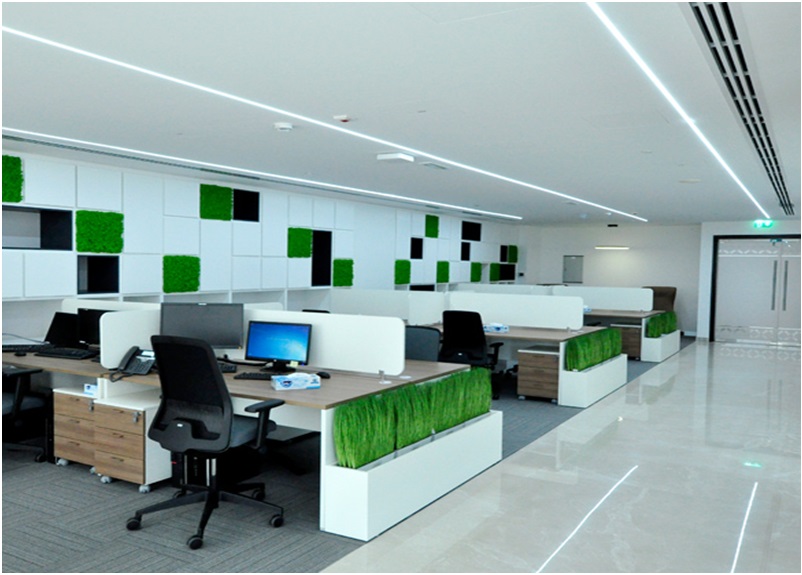The 7 Key Elements of Office Interior Designing

When it comes to office space, you would want to make sure that it looks as professional as possible. Your business will be very much affected by the way you maintain your office space. It would also leave an impression on your employees, clients, and customers. Having a professional space boosts the employees’ morales. It also provides an excellent first impression on your clients and customers, when they enter your office premises. Having a great office space is also easy on the eyes, making your business look legitimate. Your clients would consider your venture and increase the visibility of your brand.
There are many office interior design companies in Dubai to get your dream workspace as soon as possible. Having a soothing aesthetic inside your office also promotes some positivity and boosts productivity in the long run. It keeps your employees in the right state of mind. With good employee morale and productivity, your brand would thrive and flourish in the long run. When you are opting for interior designing, proper communication with the designer is essential. Make sure to convey what you want and keep an open mind.
What are the Seven Elements of Interior Design?
Interior designing concentrates on both aesthetics and functionality. However strange it may sound but both of these qualities are related to each other. Having a proper balance of both aesthetics and functionality is essential for interior design to become a success. You can take the analogy of a recipe containing different ingredients. With a proper proportion of all the ingredients, the result is a success. In this case, the seven elements of interior design bring together an appropriate balance of aesthetics and functionality.
Color
Color is not just an aesthetic choice. It also conveys and determines the mood of the people in the room. Therefore, color choice also plays a vital role in this case. The right color can also help the space and provide a healthy mental illusion. For instance, the color red is considered a sign of passion and intensity, while shades of blue and green are considered soothing and peaceful. On the other hand, yellow is a bright color and is often associated with positive, happy, and optimistic undertones. Therefore, while choosing a color, do not only focus on your visual preferences but also the energy and attitude you want to cultivate from your peers and employees.
Form
In simple words, form means shape. Of course, the artwork, contours, and furniture play a huge role in this case. Whether you are thinking about installing any portrait, artwork, or 3D object, the form will be different for these cases. There are two types of shapes and forms – organic forms, like natural, irregular, curvy, and abstract shapes, and geometric forms, like sharp edges such as squares and triangles.
Light
The lighting in your room often determines your mood. Of course, you do not want your employees to work under low lighting. But, at the same time, too much light can be counterproductive. Achieving the right balance is the key. Quality lighting is integral for any space – be it natural, man-made, or a combination of both. When choosing the lighting for your office space, make sure that the lights complement each other appropriately. For instance, think about which color of lighting do you want to use, the intensity of the lights, and whether the lights should be dimmable or not.
Line
In this case, the line is the perimeter around a form. For instance, you should outline a room before opting to install objects in that room. Lines can be either vertical or horizontal. However, the horizontal lines create a feeling of safety and security. On the other hand, the vertical lines are considered to be bold and expressive. You can also opt for dynamic sets of lines, following their own rules to add a touch of irregularity and fun to the rooms.
Pattern
A pattern is intentional repetitions of lines, forms, and other designs. It pops up on the wallpapers and fabrics to add a particular flavor to the entire design. It makes the features pop out more and adds life and motion to an otherwise bland space. However, it is essential to strike a balance not to look too tacky and chaotic.
Texture
The texture is just another way to add flavor to space. It is simply the way something feels. For instance, the surfaces can have a vintage texture or tone without even touching it.
Space
Lastly, your interior design should depend on the availability of the office space. If it is fairly small, you might not add too much pattern or furniture to it. On the other hand, you can also go for a minimalistic outlook, irrespective of space availability.
Final Take
You should visualize your dream office before hiring an interior designing company. That way, you would communicate better with the designer and tell them what you exactly want. They would also be able to put out some ideas to consider before turning the plan into a reality.